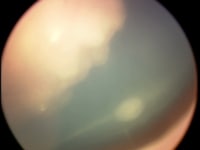
Pioneering New Approaches To Infant Eye Cancer Research
Retinoblastoma is a rare pediatric cancer of the retina. It is usually detected during "well baby" screenings, indicated by an abnormal white reflection in the eye.
Cancer formation occurs when both copies of the RB1 gene in the retina are inactive. But while there has been research into the biological mechanisms and genetic changes behind retinoblastoma, doctors still lack clear and specific progression markers for this cancer.
 Retinoblastoma tumor
Retinoblastoma tumorAgilent recently collaborated with a hospital that specializes in treating retinoblastoma patients, in order to study the complete profile of this cancer. Using tissue and tear samples , we undertook an integrated, multidisciplinary approach. We correlated data from genomics, transcriptomics, metabolomics and proteomics.
The research work took advantage of Agilent's broad range of products and solutions, including microarray scanners, LC/MS and GC/MS systems, state-of-the art software and database libraries. These diverse technologies enabled us to examine retinoblastoma at its different stages and assemble a complete profile at a metabolite, protein, gene, DNA and RNA level.
 An infant with a white 'glow' in one pupil, indicating the possible presence of a retinoblastoma tumor
An infant with a white 'glow' in one pupil, indicating the possible presence of a retinoblastoma tumorThis integrated data was then analyzed using Agilent's GeneSpring suite of bioinformatics software. This analysis helped us to gain a deeper understanding of the mechanisms and pathways leading to this disease. The software also revealed biomarkers that may be related to the progression of retinoblastoma. We were able to identify new mechanisms potentially associated with the aggressiveness of the cancer – a critical requirement for improved management and treatment of the disease.
This collaborative research demonstrates a unified approach to discovering new biological insights – an approach made possible by integrating data from different techniques in the same sample.
Using Agilent's best-in-class instrumentation, powerful software tools, and sample-preparation kits, we were able to acquire, integrate, and analyze multi-omics data. This research demonstrates the benefit of applying an integrated approach to studying the molecular mechanisms of this disease.
The ultimate result is to give children in the future a better chance for life and sight..
Related Resource: